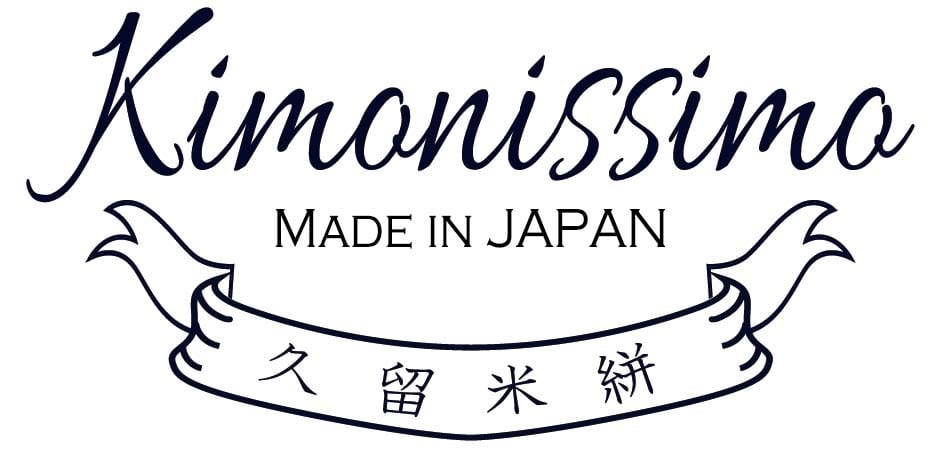





Kimonissimo Base店へようこそ!国内ヤマト運輸・ネコポス(ポスト投函型)は全品送料無料!
ご注文翌日~2営業日で出荷いたします。

【伝統工芸】【久留米絣】Kimonissimo 久留米絣ストール - 太縞 白紺ストライプ
¥7,700
■Kimonissimoの久留米絣ストール 福岡伝統の綿織物「久留米絣」を使用したストールができました。 久留米絣では珍しい、ざっくりした質感の立毛タイプのモール糸を使用した太縞の生地しております。 じゃぶじゃぶお洗濯も可能。水に通すごとに、柔らかくしなやかになっていく使い心地も魅力です。 ■久留米絣とは 久留米絣(かすり)は重要無形文化財にも指定されている綿織物で、主に福岡県筑後市・八女市・八女郡広川町などで生産されています。福岡の夏の風物詩、博多山笠の法被に使われることでも有名です。久留米絣の反物ができるまでには三十以上の工程があり完成までには二~三か月を要します。 ■商品概要・規格 品名:久留米絣ストール 品質表示:綿(久留米絣)100% サイズ:幅約38cm、長さ180~190cm 透け感:太めの糸の隙間に若干の透け感があります。 厚み:モールヤーン独特のふんわりとした厚みがあります。
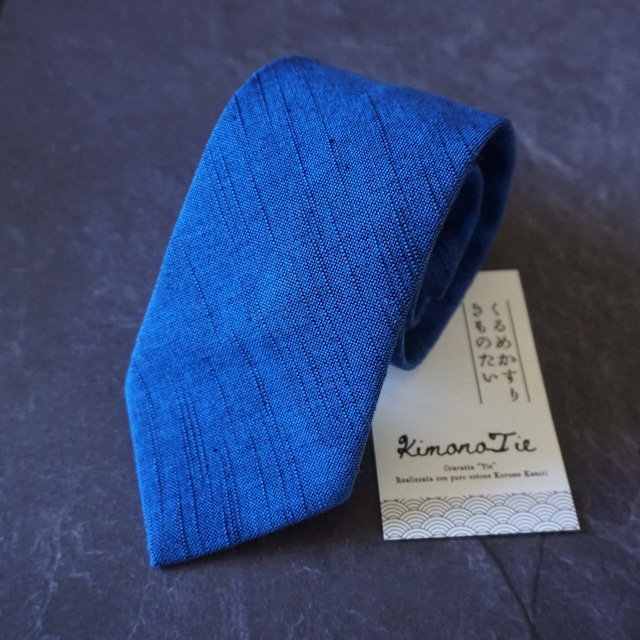
【伝統工芸】【久留米絣】瑠璃ブルー スラブ無地 | 久留米絣ネクタイ KimonoTie
¥7,260
福岡の伝統工芸である「久留米絣」の反物から作られた、瑠璃色のネクタイをご紹介します。 久留米絣は福岡県の重要無形文化財にも指定されている綿織物ですが、こちらの反物はスラブとも呼ばれる、経糸や緯糸にあえて異なる太さの糸を交えた織り方が特徴で、織りに表情を与え、さりげない風合いがありながらも、モダンでインパクトある一本に仕上がっています。 日本の伝統工芸としての久留米絣と、モダンなスタイルを融合させたこのネクタイは、ビジネスシーンやパーティーなど、様々な場面で活躍間違いなし。大切な方への贈り物や、法人様のギフト、オフィスでのお祝いのお品などにも最適です。 【久留米絣とは】 久留米絣(かすり)は重要無形文化財にも指定されている綿織物で、主に福岡県筑後市・八女市・八女郡広川町などで生産されています。模様に合わせて糸でくくる「くくり」という技法により染め分けられた綿の糸で織ることで模様ができます。久留米絣の反物ができるまでには三十以上の工程があり完成までには二~三か月を要します。 【商品規格】 品名:久留米絣ネクタイ(KimonoTie) 品質表示:綿(久留米絣)- 裏地部分 アセテート サイズ:大剣幅約8cm ※商品の色味は、写真と実物では異なって見える場合がございますので、ご了承ください。


【伝統工芸】【久留米絣】ランダム縞 黒地/赤 レジメンタル | 久留米絣ネクタイ KimonoTie
¥7,700
福岡の伝統工芸である「久留米絣」の反物から作られた、当店オリジナルのネクタイをご紹介します。 久留米絣は福岡県の重要無形文化財にも指定されている綿織物です。このネクタイでは、赤×黒のランダムな縞模様が特徴的な久留米絣を使用しています。 日本の伝統工芸としての久留米絣と、モダンなスタイルを融合させたこのネクタイは、ビジネスシーンやパーティーなど、様々な場面で活躍間違いなし。大切な方への贈り物や、法人様のギフト、オフィスでのお祝いのお品などにも最適です。 【久留米絣とは】 久留米絣(かすり)は重要無形文化財にも指定されている綿織物で、主に福岡県筑後市・八女市・八女郡広川町などで生産されています。模様に合わせて糸でくくる「くくり」という技法により染め分けられた綿の糸で織ることで模様ができます。久留米絣の反物ができるまでには三十以上の工程があり完成までには二~三か月を要します。 【商品規格】 品名:久留米絣ネクタイ(KimonoTie) 品質表示:綿(久留米絣)- 裏地部分 アセテート サイズ:大剣幅約8cm ※商品の色味は、写真と実物では異なって見える場合がございますので、ご了承ください。 ※本品内容はネクタイ1点のみです。付属品は含まれませんのでご了承ください。

【伝統工芸】【久留米絣】紅赤 レッド スラブ無地 | 久留米絣ネクタイ KimonoTie
¥7,260
福岡の伝統工芸である「久留米絣」の反物から作られた、紅赤色のネクタイをご紹介します。 久留米絣は福岡県の重要無形文化財にも指定されている綿織物ですが、こちらの反物はスラブとも呼ばれる、経糸や緯糸にあえて異なる太さの糸を交えた織り方が特徴で、織りに表情を与え、さりげない風合いがありながらも、モダンでインパクトある一本に仕上がっています。 日本の伝統工芸としての久留米絣と、モダンなスタイルを融合させたこのネクタイは、ビジネスシーンやパーティーなど、様々な場面で活躍間違いなし。大切な方への贈り物や、法人様のギフト、オフィスでのお祝いのお品などにも最適です。 【久留米絣とは】 久留米絣(かすり)は重要無形文化財にも指定されている綿織物で、主に福岡県筑後市・八女市・八女郡広川町などで生産されています。模様に合わせて糸でくくる「くくり」という技法により染め分けられた綿の糸で織ることで模様ができます。久留米絣の反物ができるまでには三十以上の工程があり完成までには二〜三か月を要します。 【商品規格】 品名:久留米絣ネクタイ(KimonoTie) 品質表示:綿(久留米絣)- 裏地部分 アセテート サイズ:大剣幅約8cm ※商品の色味は、写真と実物では異なって見える場合がございますので、ご了承ください。


【伝統工芸】【久留米絣】大縞 黒地/カラシ レジメンタル | 久留米絣ネクタイ KimonoTie
¥7,700
福岡の伝統工芸である「久留米絣」の反物から作られた、当店オリジナルのネクタイをご紹介します。 久留米絣は福岡県の重要無形文化財にも指定されている綿織物です。こちらのネクタイでは織目にネップ(綿糸のつぶ)がある、「阪神タイガース」カラーのインパクトのある太めのストライプの久留米絣を使用しています。ビジネススーツ以外にも、カジュアルなシャツとの組み合わせにもよくお使いいただいています。 日本の伝統工芸としての久留米絣と、モダンなスタイルを融合させたこのネクタイは、ビジネスシーンやパーティーなど、様々な場面で活躍間違いなし。大切な方への贈り物や、法人様のギフト、オフィスでのお祝いのお品などにも最適です。 【久留米絣とは】 久留米絣(かすり)は重要無形文化財にも指定されている綿織物で、主に福岡県筑後市・八女市・八女郡広川町などで生産されています。模様に合わせて糸でくくる「くくり」という技法により染め分けられた綿の糸で織ることで模様ができます。久留米絣の反物ができるまでには三十以上の工程があり完成までには二~三か月を要します。 【商品規格】 品名:久留米絣ネクタイ(KimonoTie) 品質表示:綿(久留米絣)- 裏地部分 アセテート サイズ:大剣幅約8cm ※商品の色味は、写真と実物では異なって見える場合がございますので、ご了承ください。 ※本品内容はネクタイ1点のみです。付属品は含まれませんのでご了承ください。

【伝統工芸】【久留米絣】雲絣紺 | 久留米絣ネクタイ KimonoTie
¥7,260
福岡の伝統工芸である「久留米絣」の反物から作られた、当店オリジナルのネクタイをご紹介します。 2本撚りの糸を緯糸に使用することによって、深みのある紺色に仕上がった、無地の久留米絣の反物から制作したオリジナルのネクタイです。ハリのある生地の質感、生地の表面のネップ(綿のつぶ)も特徴で、ツイードのような表情に仕上がっています。 さりげない風合いがありながらも、モダンでインパクトある一本です。 日本の伝統工芸としての久留米絣と、モダンなスタイルを融合させたこのネクタイは、ビジネスシーンやパーティーなど、様々な場面で活躍間違いなし。大切な方への贈り物や、法人様のギフト、オフィスでのお祝いのお品などにも最適です。 【久留米絣とは】 久留米絣(かすり)は重要無形文化財にも指定されている綿織物で、主に福岡県筑後市・八女市・八女郡広川町などで生産されています。模様に合わせて糸でくくる「くくり」という技法により染め分けられた綿の糸で織ることで模様ができます。久留米絣の反物ができるまでには三十以上の工程があり完成までには二~三か月を要します。 【商品規格】 品名:久留米絣ネクタイ(KimonoTie) 品質表示:綿(久留米絣)- 裏地部分 アセテート サイズ:大剣幅約8cm ※商品の色味は、写真と実物では異なって見える場合がございますので、ご了承ください。

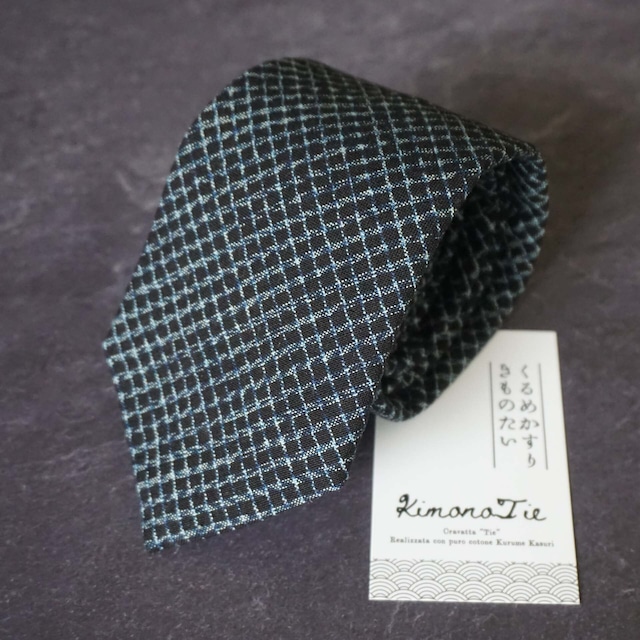
【伝統工芸】【久留米絣】文人絣 | 久留米絣ネクタイ KimonoTie
¥8,800
予約商品
福岡の伝統工芸である「久留米絣」の反物から作られた、黒地の文人絣(書生絣)柄のネクタイをご紹介します。 「文人絣」は太宰治など、多くの文筆家が愛用していたことでも知られ、「書生絣」とも呼ばれます。文人絣は細かい柄に合わせて糸を染めるため一度織って染めたものをほどいて、織るという手間のかかる工程が特徴で、細かく美しい久留米絣ならではの伝統的な柄を楽しむことができます。 当店でも人気が高い一品です。 日本の伝統工芸としての久留米絣と、モダンなスタイルを融合させたこのネクタイは、ビジネスシーンやパーティーなど、様々な場面で活躍間違いなし。大切な方への贈り物や、法人様のギフト、オフィスでのお祝いのお品などにも最適です。 【久留米絣とは】 久留米絣(かすり)は重要無形文化財にも指定されている綿織物で、主に福岡県筑後市・八女市・八女郡広川町などで生産されています。模様に合わせて糸でくくる「くくり」という技法により染め分けられた綿の糸で織ることで模様ができます。久留米絣の反物ができるまでには三十以上の工程があり完成までには二~三か月を要します。 【商品規格】 品名:久留米絣ネクタイ(KimonoTie) 品質表示:綿(久留米絣)- 裏地部分 アセテート サイズ:大剣幅約8cm ※商品の色味は、写真と実物では異なって見える場合がございますので、ご了承ください。

【伝統工芸】【久留米絣】かすれ模様 あられ模様 紺 | 久留米絣ネクタイ KimonoTie
¥8,800
予約商品
福岡の伝統工芸である「久留米絣」の反物から作られた、紺地のかすれ模様のあられ柄の久留米絣ネクタイをご紹介します。 経糸と緯糸の織りにより表現される久留米絣の柄の中でも、伝統的な「久留米絣らしい」特徴が表れています。 日本の伝統工芸としての久留米絣と、モダンなスタイルを融合させたこのネクタイは、ビジネスシーンやパーティーなど、様々な場面で活躍間違いなし。大切な方への贈り物や、法人様のギフト、オフィスでのお祝いのお品などにも最適です。 【久留米絣とは】 久留米絣(かすり)は重要無形文化財にも指定されている綿織物で、主に福岡県筑後市・八女市・八女郡広川町などで生産されています。模様に合わせて糸でくくる「くくり」という技法により染め分けられた綿の糸で織ることで模様ができます。久留米絣の反物ができるまでには三十以上の工程があり完成までには二〜三か月を要します。 【商品規格】 品名:久留米絣ネクタイ(KimonoTie) 品質表示:綿(久留米絣)- 裏地部分 アセテート サイズ:大剣幅約8cm ※商品の色味は、写真と実物では異なって見える場合がございますので、ご了承ください。
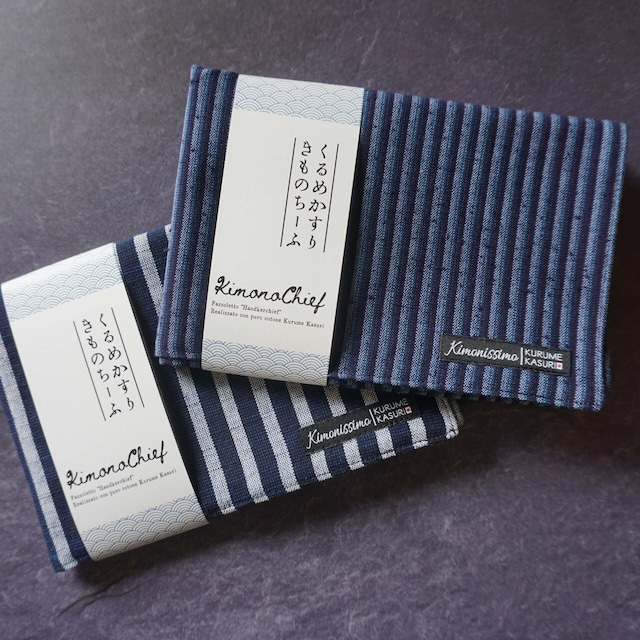
【伝統工芸】【久留米絣】どの柄が出るかお楽しみ 久留米絣 消臭抗菌ハンカチ | KimonoChief
¥1,936
20%OFF
20%OFF
どの柄が届くかお楽しみ!(久留米絣の柄はお選びいただけませんのでご了承ください。) 表地に福岡伝統の綿織物「久留米絣」、内側に抗菌消臭加工がされた木綿布「ノン臭®」を使用したハンカチーフです。綿100%生地が、表裏の二重構造になっていますので、吸水性もよく、サラサラの使い心地です。 【商品概要・規格】 品名:ハンカチ 素材:綿100%(久留米絣・抗菌消臭「ノン臭®」) 枚数:1枚 サイズ:約35cm × 35cm ※縫製工房でひとつひとつ丁寧に手作りされていますので、サイズに若干の違いが生じることがございます。 ※お洗濯で縮むことがあります。 ※片面に使用されている「ノン臭®」は、抗菌・消臭加工綿100%生地です。気になるニオイや菌の増殖を抑えます。(すべての菌に効果があるわけではありません。)


【伝統工芸】【久留米絣】どの柄が出るかお楽しみ久留米絣マスク 消臭抗菌マスク | KimonoMask
¥1,100
50%OFF
50%OFF
どの柄が届くかお楽しみ!(久留米絣の柄はお選びいただけませんのでご了承ください。) 表地に福岡伝統の綿織物「久留米絣」、内側に福岡県広川町産の抗菌消臭加工がされた木綿布「ノン臭®」を使用したファッションマスクです。 「ノン臭®」は、福岡県広川町で生産されている、抗菌・消臭効果が認められている綿100%生地です。気になる口臭や菌の増殖を抑えます。(すべての菌に効果があるわけではありません。) 【商品概要・規格】 品名:ファッションマスク 対象:かぜ、花粉、ほこり等 素材:(本体)綿100%、(ゴム)ナイロン92% ポリウレタン8% 枚数:1枚 サイズ:フリーサイズ(大人用) ●良く伸びるゴムを採用していますので、ぴったりのサイズに結び直してからご使用ください。 ●初めてのご使用前、および使用毎に洗濯してください。 ●洗濯は衣料用洗剤で手洗いし漂白剤は使用しないで下さい。 ●素材の特性上、洗濯の際に縮むことがあります。 ●洗った後は形を整えてから干してください。 ●ウイルスや有毒ガス、粉塵等を防ぐ目的では使用できません。 ●マスク熱中症にご注意下さい。 ●皮膚に異常が現れた場合、気分が悪くなった場合はご使用を中止して下さい。


【伝統工芸】【久留米絣】大縞 紺/白 レジメンタル | 久留米絣ネクタイ KimonoTie
¥7,700
SOLD OUT
福岡の伝統工芸である「久留米絣」の反物から作られた、当店オリジナルのネクタイをご紹介します。 久留米絣は福岡県の重要無形文化財にも指定されている綿織物です。こちらのネクタイでは織目にネップ(綿糸のつぶ)がある、白×ネイビーのインパクトのある太めのストライプの久留米絣を使用しています。綿織物のあたたかな雰囲気は、ビジネススーツ以外にも、カジュアルなシャツとの組み合わせにもよくお使いいただいています。 日本の伝統工芸としての久留米絣と、モダンなスタイルを融合させたこのネクタイは、ビジネスシーンやパーティーなど、様々な場面で活躍間違いなし。大切な方への贈り物や、法人様のギフト、オフィスでのお祝いのお品などにも最適です。 【久留米絣とは】 久留米絣(かすり)は重要無形文化財にも指定されている綿織物で、主に福岡県筑後市・八女市・八女郡広川町などで生産されています。模様に合わせて糸でくくる「くくり」という技法により染め分けられた綿の糸で織ることで模様ができます。久留米絣の反物ができるまでには三十以上の工程があり完成までには二~三か月を要します。 【商品規格】 品名:久留米絣ネクタイ(KimonoTie) 品質表示:綿(久留米絣)- 裏地部分 アセテート サイズ:大剣幅約8cm ※商品の色味は、写真と実物では異なって見える場合がございますので、ご了承ください。
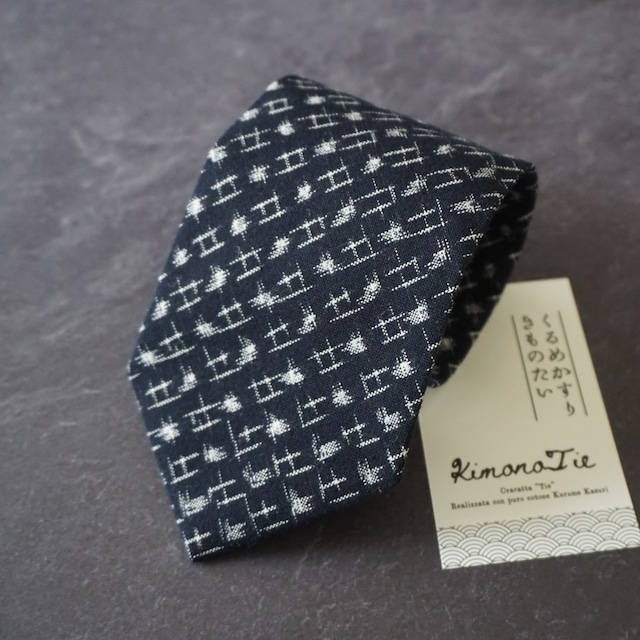
【伝統工芸】【久留米絣】井桁アラレ乱 紺 ネイビー | 久留米絣ネクタイ KimonoTie
¥8,800
SOLD OUT
福岡の伝統工芸である「久留米絣」の反物から作られた、紺地の「井桁あられ乱」柄のネクタイをご紹介します。 井桁(いげた)模様とは、井戸の上の部分の縁が模様になったものです。昔の生活には井戸が欠かせないものでしたので、家内安全の意味から、井桁のモチーフは絣や紬などの織物や、染めの着物の模様に伝統的に使われてきたほか、家紋やそこから派生した企業ロゴなどにも多く用いられています。 日本の伝統工芸としての久留米絣と、モダンなスタイルを融合させたこのネクタイは、ビジネスシーンやパーティーなど、様々な場面で活躍間違いなし。大切な方への贈り物や、法人様のギフト、オフィスでのお祝いのお品などにも最適です。 【久留米絣とは】 久留米絣(かすり)は重要無形文化財にも指定されている綿織物で、主に福岡県筑後市・八女市・八女郡広川町などで生産されています。模様に合わせて糸でくくる「くくり」という技法により染め分けられた綿の糸で織ることで模様ができます。久留米絣の反物ができるまでには三十以上の工程があり完成までには二~三か月を要します。 【商品規格】 品名:久留米絣ネクタイ(KimonoTie) 品質表示:綿(久留米絣)- 裏地部分 アセテート サイズ:大剣幅約8cm ※商品の色味は、写真と実物では異なって見える場合がございますので、ご了承ください。

【伝統工芸】【久留米絣】久留米絣ハギレ 220g | 詰め合わせ ハンドメイド材料 生地 綿
¥1,760
縫製工場で出る、久留米絣のはぎれを詰め合わせにしました。 織り上がるのに2〜3か月を要する伝統工芸の綿織物(福岡県)久留米絣。縫製工場でネクタイを製造後に生じるはぎれを廃棄しないため、ハンドメイド・手芸などにご利用いただければ幸いです。 久留米絣は着物の反物と同じで幅37センチ前後で、四角形のもの、大~小サイズの三角形などがランダムに220グラム前後、入っています。はぎれ自体の大きさや、色柄は、その時の工場での取り扱い生地に応じて、毎回違います。同じ時期に2セット以上購入される場合は、ほとんど同じ生地の組み合わせになる場合もございますのであらかじめご承知おきください。 パッチワーク、ランチョンマット、コースターやポーチなどの小物作成にどうぞ。 【久留米絣とは】 久留米絣(かすり)は重要無形文化財にも指定されている綿織物で、主に福岡県筑後市・八女市・八女郡広川町などで生産されています。模様に合わせて糸でくくる「くくり」という技法により染め分けられた綿の糸で織ることで模様ができます。久留米絣の反物ができるまでには三十以上の工程があり完成までには二〜三か月を要します。 【内容】 久留米絣はぎれ詰め合わせ(約220g) 生地の色柄・大きさ・形はお選びいただけません。 パッケージごとに入っている内容が異なります。 ※ギフトラッピング不可・ネコポス(ポスト投函・送料無料)のみ対応となります。
倉庫・発送システムの変更のため、海外発送をお休みさせていただいております。ご了承ください。